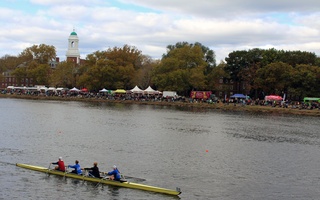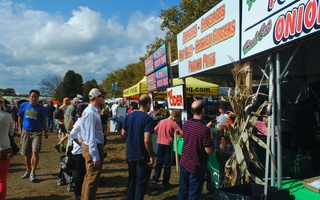When the afternoon darkens you can see them, the people by the river. Sometimes they curl on the browning grass, trouser cuffs brushing clumps of goose dung. More often they lean back on benches, hands folded, eyes closed. They sit, each alone, and face the water.
In warm months I run along the curving trails, following the line the river cuts through the jagged geography of the city. Always I look for them, my silent, still companions, the watchers of the Charles. Most seem weary. Many have just left work; their business attire, so carefully chosen in the fresh-pressed morning, now wilts, growing wrinkled and worn. Others have been at the river a long time. All have come for a reprieve, a reverie, a pause.
Soon some 400,000 spectators will throng around the banks of the Charles for the 53rd Head of the Charles Regatta. The weekend generates tens of millions in revenue for local businesses and is, as the Cambridge Boat Club says, the largest two-day rowing event in the world.
Around the time of the regatta, it is easy to appreciate the Charles afresh, to see the river as the center of our community. What we might forget is that the river is always the liquid heart of Boston and Cambridge. The Charles serves us not just during regatta weekend but every day. It hosts massive events, yes, but also welcomes loners and wanderers with equal placidity. It is the most distinctive physical feature of a geographically disjointed area and an emblem of our city’s civic attitudes.
Two hundred years ago, writes the urban planner Karl Haglund in his history of the Charles River, more than two miles of open water separated Cambridge and Boston, a length three times the present distance. Later the river’s shallow basin was dammed for mills and filled for commercial and residential projects. By the late 19th century, the Charles had become a public health calamity. At low tide the urban belt of the river would distort into a stretch of mudflats that reeked of sewage and slaughterhouse offal.
The Charles as we know it was born in the first decade of the 20th century out of a vision of the river as a great public space, one that would improve the health and lift the spirits of impoverished tenement-dwelling Bostonians and wealthy metropolitans alike. Instead of mud and sewage, the city would enjoy the sheen of fresh water.
Charles W. Eliot, a member of the Class of 1853 and the then-president of Harvard University, testified in favor of damming the river and putting the riverfront into the public domain. Anyone who “believes that cities exist and that commonwealths exist to promote the well-being of the people,” Eliot declared to a local commission, would support basin improvements: One need only to look at “the sight of the people gathered on the Charlesbank” to be convinced of the river’s civic importance.
Since the 1890s, city planners and community leaders have envisioned the Charles as a place for the people and a measure of how cities can work for the happiness of their citizens. Urban planners across Europe and America, Haglund notes, took note of Boston’s example: The Paris Exposition of 1900, for example, featured exhibits on Boston’s metropolitan park system, of which the Charles was the focal point.
Today the river—at last clean after more than half a century of “dirty water”—is not merely a feat of urban planning and conservation. It is also a symbol of the community and a haven for residents looking for a spell of peace. One of my students told me that as a lonely freshman at Harvard, he would walk to the bank of the Charles and spit into the water. By mingling with the river he would feel, for a moment, as if he belonged.
Henry Wadsworth Longfellow wrote meditatively of the Charles: “Thou hast taught me, Silent River! / Many a lesson, deep and long.”
Let us follow Longfellow’s example and celebrate the Charles not only for the events it hosts and the money it brings but for the private discoveries that take place there each day, for the gleaming mirror it holds up to the city.
You can go and see them, the river-watchers. You can walk where they haunt the banks. They sit by the river, breathing softly, eyes pressed tight—lost in the depths of reflection, trembling between the waters that lie before them and the waters that lie within.
Charles S. Tyson is a doctoral candidate in English Literature at the Graduate School of Arts and Sciences.
Read more in Opinion
Supporting the New Associate Dean of Diversity and InclusionRecommended Articles
-
Sewage Could Harm RowersRaw sewage pouring into the Charles River may endanger rowers at the Head of the Charles Regatta this weekend if
-
Grandstand for Columbia RaceA grandstand will be erected for the boat-race with Columbia, which will take place on the Charles River next Saturday.
-
 Pros and Cons of Swimming in the Charles
Pros and Cons of Swimming in the Charles -
BRIEF: Sailing Takes Competes at New England Team Race Championship, Emily Wick RegattaThis weekend, the Harvard Sailing team faced off in two regattas—the New England Team Race Championship and the Emily Wick Trophy.
-
 Top Five Roundup: Head of the Charles
Top Five Roundup: Head of the Charles













